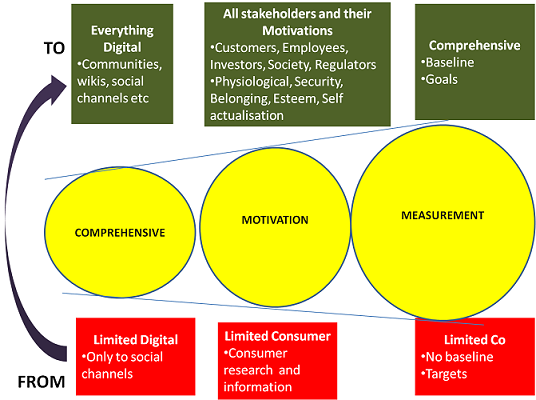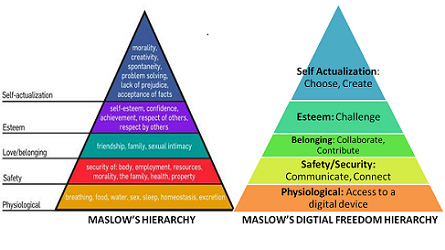Hack:
The promise of digital is not delivering on the promise
The hack has identified three major root causes due to which digital freedom has not matured to its potential and suggests a solution to work on all three root causes in a comprehensive way to bring an orbit shift in the area of digital freedom. So our proposed solution is a combination of “measurement”, “comprehensive scope” and “motivation”, if done properly, can shift the digital freedom game to the next level
“In five years time, all companies will be internet companies or they won’t be companies at all”, said Andy Grove, the Chairman of Intel, in mid 1999
Prescient as he was, even he, at that time, could not have imagined the extent to which the internet would become all pervasive.
Companies recognizing the all pervasive, society changing force of the internet survive and flourish, and those who don’t, wither.
Yahoo, innovator, first mover was one of the most popular search engines complete with directories and listings. At a time when the customer did not know what to expect of the internet, this strategy worked. But when the customer started expecting everything on the internet, Google’s powerful algorithm and simple search interface overtook Yahoo.
Even with a live example of a Google vs Yahoo, companies are slow to integrate this new scenario into all aspects of business. Take the example of social technologies: According to a study by Mckinsey in July 2012, about 1.5 billion people were social networked globally, with 80% of them interacting with social networks regularly and 90% of companies using social technologies reporting some business benefit from them. The report also goes on to say that 1/3rd of consumer spending could be influenced by social shopping, about USD1 trillion vale can be unlocked by social technologies in just four sectors, only 3% of companies derive substantial benefit from social technologies across all stakeholders: customers, employees and business partners.
Coming to the topic of Digital Freedom; one would question why this topic in the first place.
Freedom is mainly discussed when there seems to be an absence of it: we do not talk of free press or free air until there is a threat to the “free”. The need to talk about freedom is to underscore the problem/ issue/ observation by the McKinsey study: when the power of digital technology is so vast, why is its integration into business so low or even “Why the promise of digital is not delivering on the promise”.
Businesses have their own agenda: the Macmillan dictionary defines business as “ the work of buying or selling products or services for money”. If organizations and business do not realize what they are missing in terms of making money or in terms of opportunities of making money, businesses will ignore the need for digital form, or limit it to just connecting to customers because they can see that resulting in “money”.
Our Solution: A framework which can combine the following:
1. Digital freedom in its entirety
2. The motivational forces that govern people irrespective of the role that they play
3. The quantitative and qualitative measurement parameters of performance of a company

1. Digital Freedom in its Entirety
Looking at Digital Freedom again we see the following:
a. Digital freedom is usually limited to social channels:
As per the guidelines and cheat sheet reading this challenge there are the 5Cs of digital freedom. However, on reading the examples and explanations, we see digital freedom primarily alluding to social networking. Social channels are just one set of channels in the digital space, and while they seem appropriate examples of showcasing the power of digital freedom, one should look wider.
Some examples would be crowd sourcing platforms like Kickstarter or even the Android or OpenSource platforms/ communities. Kickstarter uses the combination of digital technology and crowdsourcing to enable funding of projects that pull at a person’s passions and interests. The Open Source platform is a democratic parallel development in the technology space where people collaborate, communicate and create without any real external monitoring agent – it is truly by the people, for the people and of the people.
Hence we move from digital being primarily social channels to the way digital is accessed, used, managed and interacted with.
b. Digital Freedom in organisations is whose freedom
There has been much ado about digital freedom of customers and to some degree of employees. This makes it look as if the customer and the employee are in different domains. This silo-ed approach will not work going forward. The borders are no longer defined – the customer could be an employee, cold be a shareholder, is definitely part of society. The person’s motivation and role will determine the degree of interaction with “digital freedom”. The various stakeholders we could encompasses are
- The customer
- The employee
- The shareholder
- The society
The regulator
Hence we need to look at digital freedom from the perspective of all the stakeholders of an organisation, as well as all aspects of digital, not just social media channels
2. Motivational Forces Behind Digital Freedom
What is more important than freedom is the basic motivation level of people that decides on what kind of freedom and what freedom enables. The motivations behind people rule every belief, thought and action. So instead of “freedom” alone we should be looking at motivational drivers. For this we will use the tried and tested Maslow’s hierarchy. This is a robust model used across organisations to motivate customers, staff and other stakeholders
Maslow’s hierarchy examines the basic motivator behind everything that we do even in the digital space. This coupled with the term “digital freedom” enables us to look at this holistically.
Is there a digital freedom equivalent of Maslow’s hierarchy? This will help in correlating the basic motivations of people as articulated by Maslow with the digital space.
Comparing Maslow’s Physiological need will correlate with the access to a digital device in the digital hierarchy. The next level will be about what is the most basic need addressed by digital access – here it becomes “connection or communication”.

The next level of “belonging” as per Maslows correlates with “Collaborate and Contribution”, as made available by now having access to a digital device and being able to connect or communicate. The level above “belonging” in Maslow’s hierarchy is Esteem. Our interpretation of esteem is to respect others and be respected and “challenge” whatever or whoever does not do so. The last level of self actualisation is to choose and create in the digital hierarchy.
We then take this and create a more simplified scale of digital freedom.
3. Digital Freedom as a Key Component to the Quantitative and Qualitative Measurement Parameters of Performance of a Company
There has been much ado about digital freedom of customers and to some degree of employees. Lack of a proper measurement mechanism with baseline and goals is a major roadblock to the progression of Digital to the levels it deserves. As the old saying goes what gets measured gets achieved, we recommend that companies adopt a stringent and comprehensive 'Digital Balance Score Card' (DBSC) by first measuring and establishing a baseline on the parameters relevant to its various stakeholders, then establish audacious goals for each parameter giving it competitive advantage and finally, tracks progress at various governance levels. The progress tracking must take place at both strategic levels as well as operating levels within the company forums including the Board, Management teams and operating team levels – quite somewhat like the various players in the Kaplan BSC.
This approach of DBSC will help companies adopt and progress the digital challenge in a structured way with accountabilities rather than leaving it for self adoption and other methods.
A sample DBSC is given below which can be customized to specific businesses
A. Customer measures:
- number of channels and devices available to connect (FB, youtube etc) for Sales and Service
- frequency and quality of digital communication (two way)
- purchase and repeat purchase through Digital
- Ease and speed of digital access
B. Employee measures:
-number of channels and devices (BYOD)
- frequency and quality of digital content
- on line training hours
- number of digitally enabled employee initiatives
- digital satisfaction survey scores
- number of complaints and fulfillment requests logged and resolved
C. Shareholder measures:
- total revenue from Digital
- percentage revenue spent on Digital
- total profit from Digital
- total customer base on Digital (sales and service)
- percentage media spend on Digital
D. Society measures:
- search ranking on major search engines
- linkage / compatibility to social media channels
- number of non-revenue Digital initiatives
- penetration into social networks.
In sum, to enable and empower real digital freedom, and hence the promise of digital to actually deliver of the promise, we need an approach that is able measure a company’s performance in a way as to combine the various roles that people play, what is the driver behind people as a whole, in an environment where the digital domain is beyond social media. The degree across parameters of freedom and its implications should be seen in its totality.
This perspective will transform the way to look at digital freedom and measure it
It will measure in a new way the real impact of digital freedom in an organization, and its implications on strategy and growth
It will create benchmarks that will help organizations create goals and indices to keep evolving and improving
It will help create a transformation in this area alone when one moves from neyond the anecdotal to something that is backed by data.
The challenge is to create a robust framework that encompasses the approach. The more the number of organzations that have been sampled, the more robust the framework. The challenge will be in accessing the data of more and more organizations of various sizes and mindsets.
The second challenge will be in the benchmarking of the motivations as per Maslow's hierarchy. The degree of complexity is dependent on us, the analysts. But there are various hacks even in this.
We will create the framework basis our rationale and gather data from various organizations. This will be a cobination of publicly available data ad some, wherever possible, getting data from the companies themselves. With this we intend to cover a wide spectrum of cmpanies in sizes and types - large corporate houses, to startups, and across industries (from finance to a technology based company), b2b as well as b2c, etc.
We will then analyze this and generate a simple 2x2X2 matrix that can be further simplfied into one single 2x2 matrix. These will help in creating few segments of profiles. Different startegies would be recommended for different profiles to reach an end goal of digial freedom.

Sanjeev Mago
Managing Director Kohpal Consulting
 Lira Priyadarsani
Lira Priyadarsani
Managing Director, Web of Comms
Digital freedom doesn't need to be viewed from a technical perspective 'only'. The subject needs to be addressed from a holistic perspective of management and motivation. If the basic management concepts and motivational factors are addressed properly and adequately, Digital will have a far reaching impact.
- Log in to post comments




You need to register in order to submit a comment.